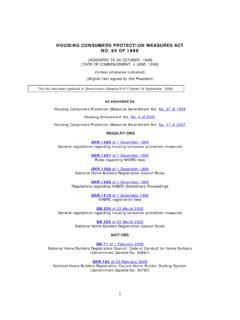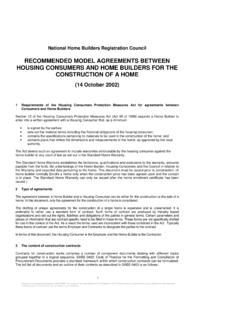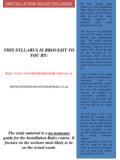Transcription of National Department of Housing DESIGN AND ... - …
1 REPUBLIC OF SOUTH AFRICA National Department of Housing DESIGN AND CONSTRUCTION OF HOUSES Project Linked Greenfield Subsidy Project Developments Generic Specification GFSH-11 April 2003 PROJECT LINKED GREEN FIELD SUBSIDY Housing PROJECTS Generic specification ( April 2003) DESIGN and construction of houses INTRODUCTION Introduction Specifications for houses may be described as being: i) Prescriptive in terms of which a collection of codes and standards are used to describe how houses should be designed, constructed and maintained. ii) Functional in which qualitative functional statements are made but no quantitative user or technical performance criteria are prescribed.
2 Iii) Performance-based in which: a) qualitative functional requirements are established; b) quantitative user and technical performance criteria are provided; and c) acceptable solutions and evaluation and DESIGN tools are offered. This specification is a performance specification that is driven by user requirements for a number of basic Housing attributes. Its key objective is to satisfy user needs and requirements. This it does by identifying and capturing user requirements for a number of attributes and translating them into functional and performance criteria and providing a framework within which such requirements and criteria may be satisfied.
3 The performance-based approach has a hierarchy that starts with a user need (a general statement of requirements for a house to be regarded as being satisfactory by the user ) for each house attribute, followed by a performance description (a statement which identifies agents that affect performance in a qualitative manner and establishes how these agents affect the state of the house) and performance parameters (user requirements expressed in terms of the quantitative performance of a house attribute). The means of verifying that the construction solution offered also needs to be provided so that compliance with the requirements of the specification can be readily demonstrated or predicted.
4 (See Figure 1). Typically, the performance evaluation for prediction or the verification of performance requirements can be roughly divided into application of rules, testing, verification methods, documentary evidence and expert judgement.. Assessment by a competent person USER NEEDS PERFORMANCE DESCRIPTIONSPERFORMANCE PARAMETERSCONSTRUCTION SOLUTIONBy application of deemed-to-satisfy DESIGN and / or construction rule By application of well established engineering principles (rational DESIGN ) By testing or assessment (rational assessment) By expert opinion and judgment Adoption of a deemed-to-satisfy solution Figure 1: The performance based approach to the procurement of houses Performance requirements Deemed-to-satisfy DESIGN and construction rules typically include examples of materials, components, geometric configurations and construction methods, which if complied with, provide satisfactory evidence that the applicable performance requirements have been met.
5 Such provisions are essentially prescriptive in that they explain step-by-step what is necessary to demonstrate compliance. Put in another way, they are a recipe for minimum construction that satisfies all requirements and constitute one option for verifying that applicable performance requirements have been met. Unavoidably, deemed-to-satisfy provisions are conservative in their formulation and only cover the most common forms of construction. On the other hand, assessments by competent persons can be applied to any form of construction to provide satisfactory evidence that a performance description is satisfied for the nominated performance requirements.
6 Such assessments are likely to be less conservative. Competent persons can be either natural or juristic persons, registered engineers which have competence by virtue of their experience and training or certification agencies such as Agr ment South Africa that engage technical experts to evaluate Housing systems comprising materials and elements whose properties, characteristics and behaviour are not well known. The National Building Regulations are generally functional in nature ( they set out what is required of a building or element or component thereof in respect of a particular characteristic without specifying the method of construction, dimensions or material to be used).
7 They do, however, contain some performance-based regulations and make provision for prescriptive requirements through deemed-to-satisfy requirements. The National Home Builders Registration Council s technical requirements are also functional in nature. Accordingly, compliance with this specification will generally result in compliance with the National Building Regulations and the NHBRC s Technical Requirements. Compliance with these documents should, nevertheless, be confirmed. The National Building Regulations and the NHBRC s Technical Requirements published in terms of the National Housing Consumer s Protection Measures Act contain ways in which health and safety requirements may be satisfied.
8 The approach adopted in both these documents is illustrated in Figure 2. This generic specification only deals with how requirements may be satisfied and not by whom. Other specifications dealt with the by whom . There are a number of attributes which could be considered in Housing , viz: ATTRIBUTE TYPICAL CONSIDERATIONS Adaptability The capacity of a house to be altered or extended. Aesthetics The appearance of a house. Constructability Transportation to site, erection, health safety. Durability Retention of performance over required service life with specified maintenance.
9 Economics Initial, running and maintenance costs, demolition costs, life cycle costings. Energy efficiency The extent to which the building envelope optimises the amount of energy required to achieve a required level of indoor climatic control. Fire safety Egress, fire suppression, fire resistance, risks of outbreak of fire and of spread of fire, physiological effects (smoke control and ventilation), and evacuation time (escape routes). Functionality /Accessibility / Accident safety Number, size, geometry, subdivision and interrelation of spaces. Circulation patterns and ease with which a room can be furnished; ease of access and provision for children, aged and disabled; protection against gas explosion, sharp points, edges, protection during movement, falls, slipperiness, obstruction.
10 Housing systems comprising materials and elements whose properties, characteristics and behaviour ARE well known Housing systems comprising materials and elements whose properties, characteristics and behaviour ARE NOT well known Typical ways of demonstrating compliance with the structural requirements Type of Housing system Apply DESIGN and construction rules set out in SANS 1082 and Parts H, J, K, L, M and N of SANS 10400. Appoint competent person to prepare a rational DESIGN in accordance with SANS standards Appoint competent person to prepare rational DESIGN / perform a rational assessmentUtilise building systems and components which have Agr ment certificationFigure 2: Ways of satisfying structural requirements Safety during movements and circulation (limitation of floor slipperiness, unobstructed passage, guard rails, etc).








